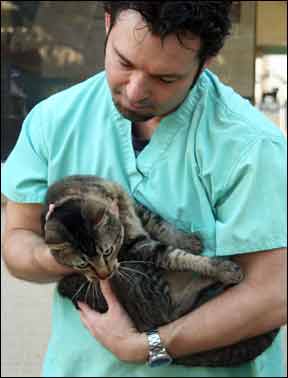Beware Onions and Garlic for Pets
Onion, garlic, leek, chives, shallots and scallions are all part of the genus, Allium. Unfortunately, all Allium species can be poisonous to dogs and cats; their toxic components can damage red blood cells (RBC), leading to a hemolytic anemia. Cats in particular are two to three times more susceptible to RBC damage from these components than other species. Onion toxicosis is noted in animals that consume more than 0.5 percent of their body weight (for instance, for a 10 lb cat, this would be 8 ounces).

288
However, ingestion of smaller amounts over several days can lead to RBC damage. Notably, manufacturers often add onion powder to baby food to increase palatability — and baby food is often given to ailing cats to entice eating. Commonly, signs lag behind consumption by a few days — vomiting, diarrhea, loss of appetite and dehydration may occur. Treatment is mainly supportive. Obviously, owners should restrict access to these foods.
Squamous Cell Carcinoma
Squamous cell carcinoma (SCC) is the most common malignant neoplasm of feline skin and mouth. In humans, it has been suggested that human papillomaviruses — along with ultraviolet light — may act as cofactors in human skin cancer. These researchers (“Detection of human papillomavirus DNA in feline premalignant and invasive squamous cell carcinoma, Veterinary Dermatology, 2011) determined the prevalence of papillomavirus in cutaneous and non-cutaneous pre-cancerous or cancerous lesions (SCCs) in 84 cats using virus genetic detection (PCR).
Evidence of papillomavirus infection was found in 20 of the 126 samples tested. Fifty percent were found to be most similar to human papillomavirus. The role of UV light in feline SCC remains unclear, and any causal relationship between SCCs and papillomaviruses in cats cannot be concluded. Because papillomavirus was present in more cases than originally identified, researchers hope for a larger prospective study to determine its role.
Your Veterinarian’s Best Advice
Fifty-one percent of veterinarians reported a net decrease in patient visits over the last two years, while 42 percent said that revenues decreased in 2010 as compared to 2009. This decline continues a trend that has been documented over the last decade, even while the number of dogs and cats has increased in the United States.
Yet in spite of these issues, there are steps veterinarians can take to reverse the trend and improve pet health, according to a new study regarding the demand for veterinary services announced at the annual convention of the American Veterinary Medical Association.
Called the Bayer Veterinary Care Usage Study, the research was conducted by Bayer HealthCare LLC, Animal Health Division along with Brakke Consulting and the National Commission on Veterinary Economic Issues (NCVEI).
The study confirms that there is a gap in knowledge between pet owners and veterinarians when it comes to providing long-term health of companion pets. Nearly all (95 percent) veterinarians surveyed believe that dogs and cats require at least one well-visit, or physical examination, annually and that 72 percent of veterinarians believe wellness exams are the most important services they can provide. However, the study also found that 65 percent of veterinarians believe their clientele doesn’t value annual wellness examinations, which underlines the findings from the study’s first phase.
“Our initial findings from pet owners established the misperception that regular veterinary check-ups were not vital to the ongoing health of their pet,” said Ian Spinks, president and general manager of Bayer Animal Health North America. “What we are now being told by veterinarians is that they believe the development of an annual wellness program for their patients is likely the single most important service that they can provide.”



